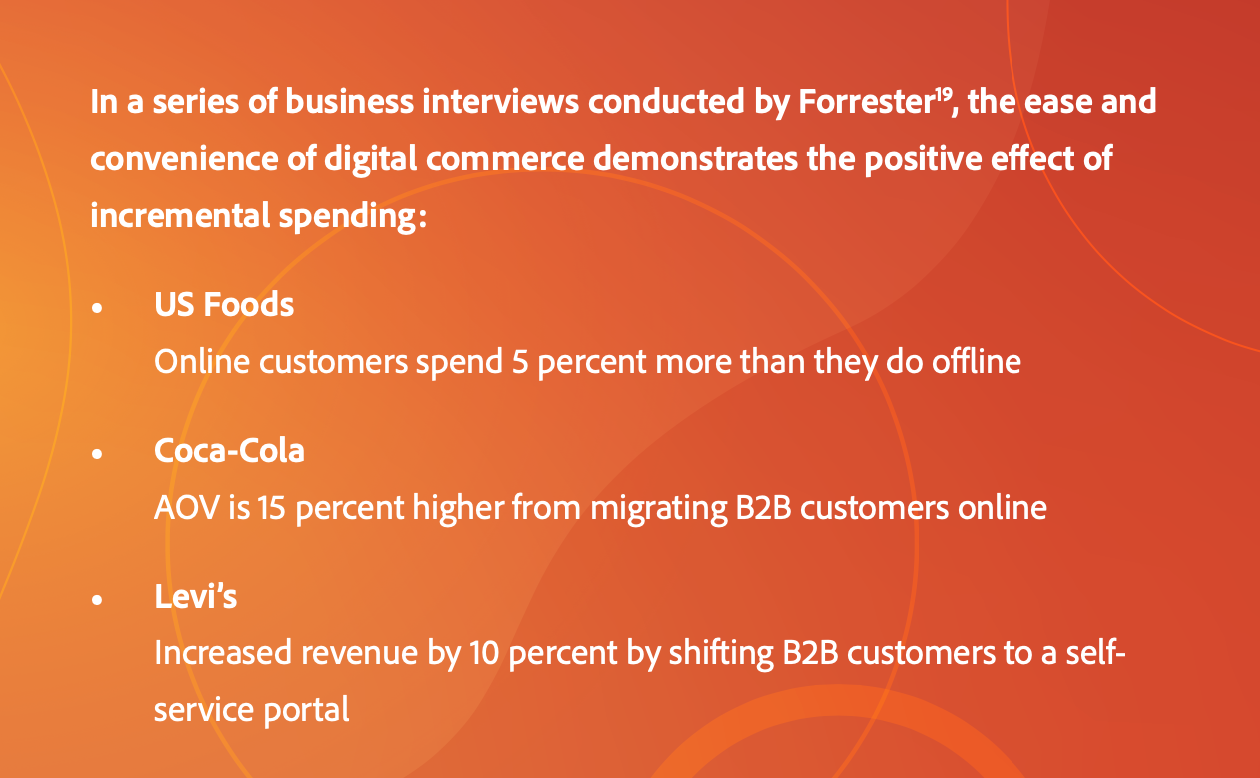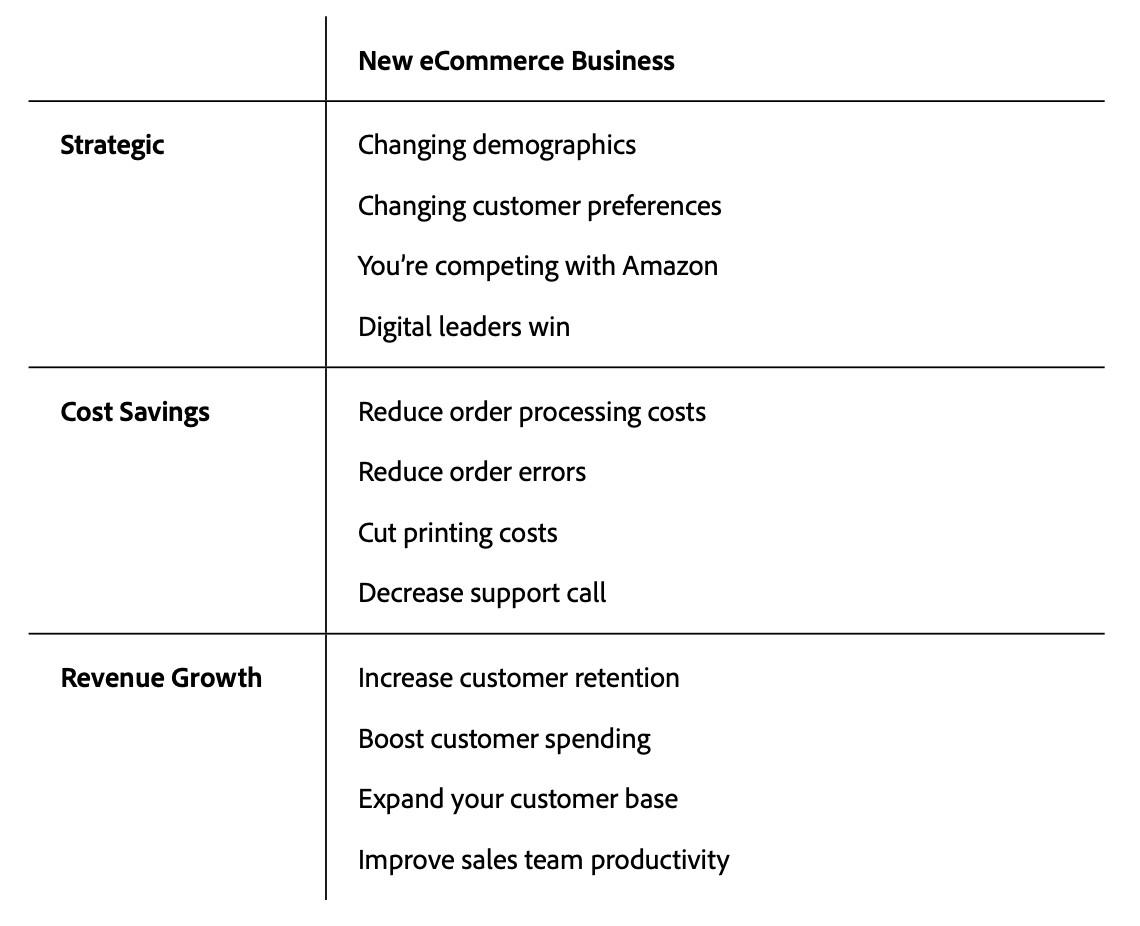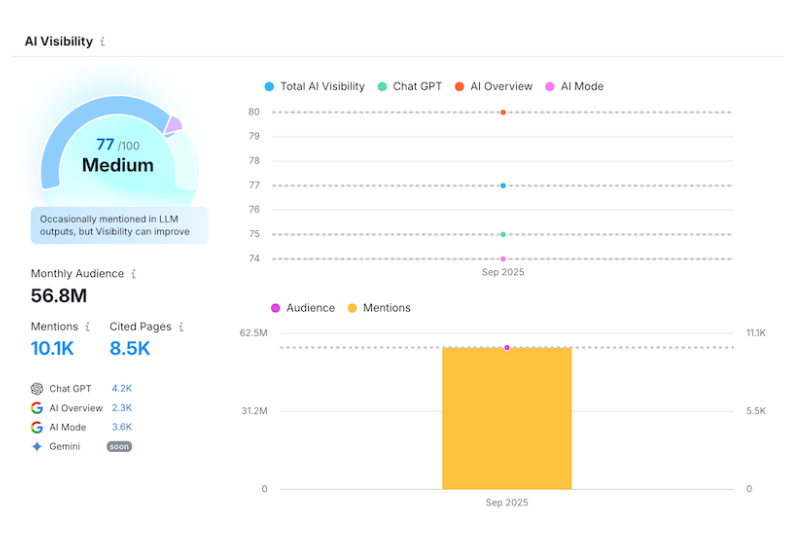Bringing Your B2B Business into the Digital Commerce Era

Creating a compelling business case for eCommerce integration
Introduction
The global growth of eCommerce has shifted attitudes towards digital modernization across a breadth of B2B industries. In 2018, B2BecNews conducted a survey of 218 manufacturers, wholesalers, and distributors. While 61 percent of manufacturers and 38 percent of wholesalers were not transacting online, 75 percent of these surveyed firms were planning to launch their own eCommerce platforms within two years.
Organizations resistant to eCommerce integration are doing themselves a disservice. The alternatives are expensive, counterproductive, and place them behind competitors actively adopting new technologies. Communicating the value of digital commerce to key decision makers requires a persuasive case appealing to business factors including strategic outlook, cost-savings, and revenue growth.
Become the champion of change your business needs. This guide provides three persuasive approaches — supported by the data of leading industry authorities — to help you sell the value of digital integration to stakeholders within your organization.
A Strategic Outlook: A look ahead prepares you in the present
Success in the digital commerce era begins by understanding your audience demographics and their service expectations. It also involves acknowledging competitors entering your industry space and how well you’re prepared to counter them. Doing so can help you identify shortcomings within your organizations existing infrastructure, giving you a platform for communicating the value of a digital commerce approach.
Changing Times, Changing Buyers
Projected to represent 44 percent of the workforce by 2025, digital-savvy millennials are swiftly taking over purchasing responsibilities. Presently, 73 percent of individuals aged 20 to 35 are helping decide which products and services to buy at their respective companies, with a third of this demographic being the sole decision makers. Having grown up in an era of accelerated technological innovation, millennials expect purchasing experiences to mirror the eCommerce environments they navigate as consumers.
- Default to Digital
When researching products and services, 85 percent of millennials default to social media, vendor websites, and search engines, with mobile and video formats preferred
- Make Way Middleman
43 percent of millennial buyers favor direct manufacturer relationships versus going through a distributor, with 20 percent willing to pay a premium to do so
- Stand for Something
80 percent of buyers appreciate companies whose mission aligns with their interests in social issues, a factor which notably impacts final purchasing decisions
Buyers Across All Age Groups are Going Digital
Changes in buyer demographics aren’t limited to millennials, as individuals across all age groups favor the speed and convenience offered by digital channels. Organizations which fail to invest in digital, and continue to rely solely on large sales teams, will lose ground to future- thinking competitors.
- 90 percent of B2B buyers conduct research online before committing to a purchase
- 74 percent view website purchases as more convenient than buying from a sales rep
- 84 percent prefer to make repeat purchases through online channels
The Encroachment of Amazon and Digital Leaders
Even if a strong digital player has not entered your industry, it is only a matter of time. When this happens, your reliance on phone and email ordering options will negatively effect customer loyalty. In fact, Amazon Business and other digital-only players are taking direct aim at many B2B industries.
Amazon is expected to capture 10 percent of the US B2B market and 5 percent of the international market by 2021, reaching $33.7B in sales by 2023. Continuing to invest heavily into streamlining its B2B services, Amazon offers business buyers an expansive range of convenient features and functionality.
- Greater catalog depth offering more products to choose from
- Competitive “business-only” pricing
- E-procurement system integration
- Support for purchasing cards, lines of credit, and tax exemption
Digital Leaders Win
Embracing change and investing in digital leadership offers your organization real, quantifiable rewards. McKinsey research shows B2B digital leaders see five times more revenue growth than their peers. Additionally, data from Forrester Consulting supports the value of investing in experience-transformation, including 1.6x higher YoY increase in orders and 2x higher loyalty metrics.

Visualizing Cost Savings: Going digital eliminates drains of business resources
The best way to save money is not losing it in the first place. Over time, costs associated with order processing, manual entry errors, and customer support can negatively affect your bottom line. Today’s eCommerce technologies can automate internal workflows while encouraging a self-service customer experience, freeing up resources towards more constructive business objectives.
eCommerce Reduces Order Processing Costs
One way to nurture customer loyalty is by providing a fast, frictionless purchasing experience. A digital commerce platform can significantly reduce order processing costs by encouraging self-service ordering, easier quote management, and assisted selling.
- Self-Service Ordering
Sales and call center teams can eliminate manual order entry, particularly valuable when working with smaller, less profitable customers
- Simplified Quote Management
Customer quote negotiation can be managed through a streamlined, fully documented process which tracks all relevant elements, enabling buyers to checkout online once an agreement is reached
- Easier Assisted Selling
Sales reps can access a centralized admin to create client orders, troubleshoot issues, and leverage data on recent purchases to make product recommendations
An easy way to estimate the cost savings benefit of moving orders online is to multiply the cost of handling an order over the phone by the number of orders that will shift to self-service.
The percentage of orders which move online will vary based on your industry, strategy, and other factors. However, many of Adobe Commerce (Magento) customers see 10 percent or more of their order volume transition online in the first year.
Online Ordering Cuts Error Rates for Improved Profitability
Errors can occur frequently throughout the manual ordering process. These mistakes not only eat up time and resources, failing to deliver as expected affects customer satisfaction and their sense of trust. By moving to a digital self-service model, you can reduce the frequency of these costly transaction errors and preserve the integrity of your customer experience.
- Customer-Specific Catalogs and Pricing
Prevents customers from ordering the wrong products at the wrong prices
- Automated SKU Checking
Each SKU is confirmed as valid, in stock, and available before the order is placed, preventing errors and reducing time spent managing returns
- Customer Self-service Ordering
Prevents transcription errors, sales rep miscommunication, selection of the wrong address, etc. as the customer can enter and review an order prior to finalizing
“Digital is deflecting a growing percentage of B2B customer calls and greatly reducing the cost of ordering and the overall cost to serve customers.”– Forrester
An Online Customer Portal Reduces Support Costs
Investing in eCommerce leads to savings beyond just processing transactions. By giving your customers a centralized service hub to manage their most common tasks, you can significantly cut inbound inquiries across several areas. With less support demand, you reduce operating costs and focus resources towards scaling your business faster.
Adopting a self-service portal empowers customers to:
- Access invoices and return products
- Confirm inventory level by stock location
- Check on order status and shipping information
- View overall company spending reports and data
eCommerce Investment Means Retiring Your Physical Catalog
While print media is alive and well, the cost of designing, printing, and distributing a physical catalog may offset its overall business value. By going online, customers can instantly receive the latest product information in a convenient digital format.
- Save on printing costs, postage, and the cost of sending addendums with updated information
- Get products to market faster and inform customers of new offerings without waiting on an updated catalog release
- Make it easier to handle substitutions by pointing customers to comparable products if something is out-of-stock or a product is discontinued

Ramp Up Revenue Growth: Advanced Commerce Capabilities to Grow Your Brand
An online sales format introduces several new ways to increase your revenue. From a buyer’s perspective, the speed and convenience of digital commerce equals higher satisfaction, in turn motivating them to spend more. From a business perspective, digital enable sales teams to work more efficiently and channel efforts into revenue growth.
Adding eCommerce Improves Customer Satisfaction and Retention
Part of revenue growth involves understanding and correcting your customers’ pain points before they’re vocalized. Digital commerce addresses and corrects inefficient B2B processes which include slow purchasing procedures, lack of responsiveness, and limited account control. By streamlining these components, companies can elevate customer satisfaction, leading to profound impacts on retention and financial performance.
- McKinsey found a top service issue among B2B buyers was frustration over slow response times, reported by 40 percent of their buyers
- Harvard Business Review determined responsiveness is a top three loyalty driver in their research with IT infrastructure buyers

Omnichannel Commerce Boosts Customer Spending
Omnichannel offers more channels for customers to communicate with your brand and purchase the products they need. In fact, Forrester reports customers are motivated to spend more overall when they engage with multiple channels. By establishing a digital commerce channel, you can begin using features which encourage customer spending.
- Conveniences such as 24×7 purchasing, easy purchase list set up, and no wait times to connect with sales
- Expedited quote requests, immediate stock level visibility, and real- time order status updates
- Products are easier to find with sites designed for browsing and discovery versus scanning spreadsheets or physical catalogs
- Cross-sell and up-sell capabilities let you proactively recommend additional purchases
- Targeted offers such as free shipping or other incentives for larger orders
eCommerce Enables B2B Companies to Expand Their Customer Base
Modern businesses aren’t just acting locally, they’re thinking globally. Today’s eCommerce platforms let you escape regional restraints and break into B2B markets worldwide. Using a dedicated eCommerce solution, you can increase the pool of available prospects by servicing customers and industries either previously difficult to reach or unprofitable.
- Expand into Cross-Border Commerce
With eCommerce you can sell across borders by using built-in support for multiple languages, currencies, payment methods, and tax policies
- New Customer Segments
Expand into B2C/D2C selling or target new industry verticals with tailored content and product offerings
- Satisfy Smaller Customers
Profitably handle customers who place small or infrequent orders with online-only purchasing and support
- Reengage Inactive customers
Many customers will return once they discover you offer easy-to-use online purchasing
Digital Capabilities Improve Sales Team Productivity
Digital channels can dramatically boost your sales team’s productivity. A modernized platform solution puts vital information at their fingertips to reach additional customers and close more deals faster, all without expanding your existing talent pool.
- Sales reps have immediate access to detailed product information, videos, and selling resources, accessible online or via mobile devices
- More time can be focused on consultative selling for large, complex opportunities or new business, thanks to less time spent manually entering phone or fax orders
Final Thoughts
The majority of B2B commerce projects are centered around the concept of change management. Even after proposed strategies receive an executive sign-off, you must continue promoting the advantages of digital integration throughout the organization. You want to set the stage for what will be continued, necessary investment to support this channel.
Your digital adoption initiative should be positioned as an ongoing enrichment effort rather than a project with a hard completion date. Explain why you are investing in eCommerce, what it will bring to your business and customers, as well as how it will improve internal processes. The ideal approach is to pursue small successes and quick wins which demonstrate progress, in turn stimulating internal momentum.
It’s human nature to approach change with caution. However, you can reduce the perception of risk by consistently communicating your vision and uniting like-minded individuals who can help spread the value of change. Most importantly, ensure the customer experience is at the forefront of discussion throughout every stage of the planning process. Focusing on the best ways to exceed customer expectations will highlight the importance of your initiatives.
Conclusion
Here is a quick summary of the ideas we’ve shared which you can use as a checklist when creating your own business case.

Learn more about how Adobe can bring your B2B business into the digital commerce era—get in touch with Human Element today!





